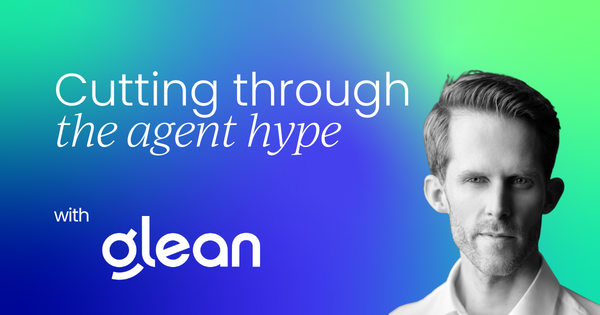Let me start with a confession: I work in go-to-market, which means I pitch every single day. So, writing this without sounding like I'm selling something? That's going to be tough. But stick with me – I promise the insights are worth it.
The uncomfortable truth about AI failures
Here's a question that might make you squirm: Have you seen that study floating around claiming that 95% of all AI pilots fail?
Now, here's where it gets interesting. When I ask enterprise leaders if they believe this statistic, most nod their heads. But when I ask those same people running AI projects if their initiatives are failing, suddenly the room goes quiet.
Something doesn't add up, right?
Whether the exact number is 95% or something lower doesn't really matter. What matters is that a significant portion of AI projects are failing, and I've spent the last year dissecting why this keeps happening, especially with large enterprise customers.
The three reasons AI projects crash and burn
1. Your AI doesn't actually understand your data
Picture this: It's 2022, and company boards everywhere are having their "ChatGPT moment." They're simultaneously amazed and terrified. The immediate reaction? "We need to control this before everyone uploads our data to the public internet!"
So what happens? Companies rush to build their own "Company GPT" – usually just OpenAI or Anthropic wrapped in enterprise security. And yes, that's important for keeping your data safe.
But here's the kicker: These solutions often lack scalable connectors to your actual enterprise data. You're still manually dragging and dropping files like it's 1999. How many of you dropped a file into ChatGPT this week? (I bet it's more than you'd like to admit.)
Meanwhile, every SaaS company is scrambling to be "AI-first" because, let's face it, if you're not AI-powered in today's market, good luck getting funding. But these tools only see their own vertical slice of data – like a horse with blinders on.
The result? You ask your AI a question, and the response makes you go, "Is that... really what I expected?"
2. People resist change (Especially when they think you're replacing them)
Remember those board directives from 2022? "Build AI, but make it compliant!" Classic top-down approach. But then reality hits.
Employees start asking uncomfortable questions:
- "Am I allowed to use this?"
- "Are the AI policies even clear?"
- "Wait, am I training my own replacement?"
You're not just implementing technology; you're fighting human psychology. And humans, as we all know, aren't always thrilled about change.
3. Everyone's building their own AI kingdom
Here's a fun fact: Germany is OpenAI's second-largest market for ChatGPT usage. We're innovative! We want this technology!
But in the enterprise reality, every department now has their own "AI ninjas" (probably including you). Everyone's cooking their own soup, as we say in Germany. Marketing has their tools, sales has theirs, engineering is building something completely different.
Without a solid backbone, you end up with a bunch of disconnected AI experiments that don't scale. It's innovation theater, not transformation.

The path to AI that actually works
So how do we flip the script? How do we move from "this helps me write emails faster" to genuinely transformative AI? Here are three counterpoints to the problems above:
1. Context is everything (Data alone means nothing)
Here's an uncomfortable truth: Your Salesforce is never up to date. No repository managed by humans ever is. The real truth about any project or deal is scattered across Teams conversations, emails, SharePoint presentations, and a dozen other systems.
To make AI actually useful, you need two things:
- Connections to your entire data corpus (not just one vertical solution)
- Understanding of how data flows through your organization
We've found you need about 70 signals for every data point to properly rank information for AI ingestion. That includes not just who created something, but who's sharing it, commenting on it, which presentations actually close deals, and what the most recent quotes look like.
2. Solve a real problem first
Instead of forcing AI on people, start with something everyone struggles with: finding information.
Think about it. There's data you know exists (because you created it), and there's data you don't know exists but would be incredibly helpful. How often do you discover someone else was working on the same thing? That duplication kills productivity and budgets.
Start by solving search. Then layer on AI to summarize findings. Finally, add agents to act on insights. This natural progression draws people in rather than forcing adoption.
3. Build once, scale everywhere
Building a stable, scalable, compliant AI foundation is hard. Really hard. You need:
- No PII leaks from your data corpus
- Permission-aware access (so I can't search "what's my manager's salary?")
- Real-time updates when someone shares new data
- Technology agnosticism (because who knows if next year's best model will be from Google, OpenAI, Anthropic, or someone we haven't heard of yet?)
A real-world success story: Deutsche Telekom
Let me share a concrete example. Deutsche Telekom (yes, that Deutsche Telekom) rolled out their AI assistant "AskT" to 80,000 employees.
Here's how it transformed just one function – customer support:
Before: Customer calls with a problem. Agent puts them on hold while searching multiple databases. Customer gets increasingly frustrated.
Today: Customer's question is transcribed directly into AskT. Agent gets an immediate, referenced response. Problem solved quickly.
This isn't just about efficiency. It's about transformation. Happy customers renew contracts. They tell friends about their positive experience. The competition starts looking slow and outdated.
And that's just one department. Imagine every executive summary, customer email, or engineering investigation automated or accelerated across your entire organization.

What would you do with that time?
Here's the real question: If AI could handle the routine search-and-summarize tasks that eat up your day, what would you do with the extra time?
- Sales teams could spend more time with customers
- Support teams could provide better resolution
- Engineers could ship products faster
That's the transformative power of AI – but only when it's built on a rock-solid foundation that actually understands your complete data landscape.
The bottom line
Making AI transformative isn't about having the fanciest models or the biggest budget. It's about:
- Connecting AI to your complete data context (not just silos)
- Empowering employees by solving real problems they face daily
- Building on a secure, scalable platform that can adapt as the technology evolves
Get these three things right, and you'll be in the 5% of AI projects that don't just succeed – they transform how your company operates.
The question isn't whether AI will change your business. It's whether you'll be driving that change or watching from the sidelines.



 Follow us on LinkedIn
Follow us on LinkedIn




